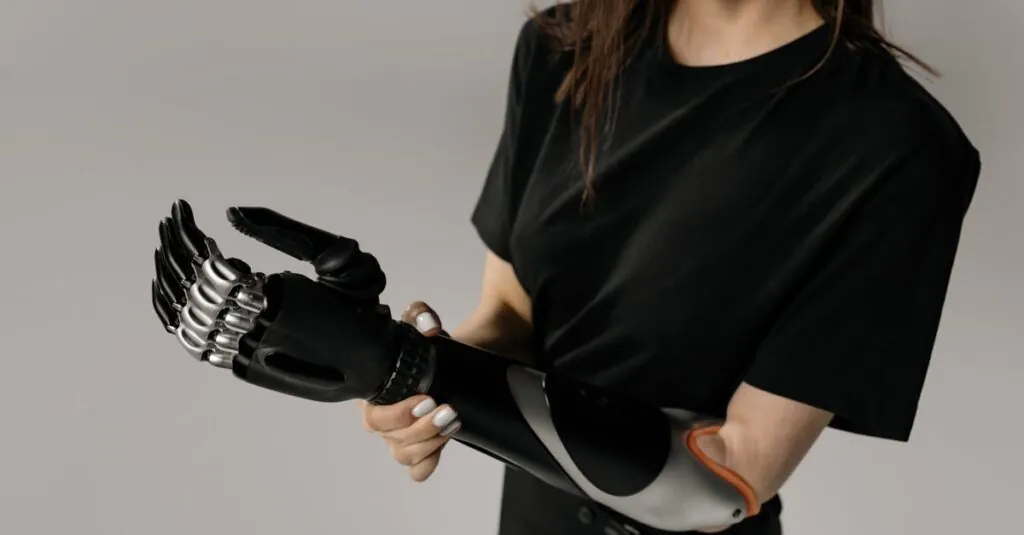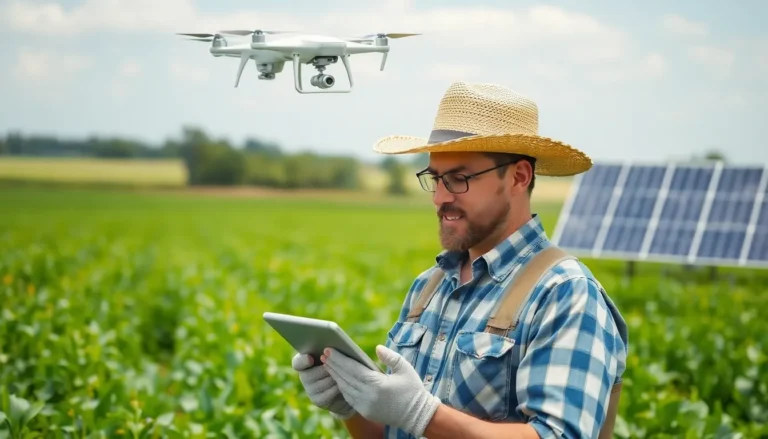Table of Contents
ToggleIn a world where robots are no longer just for sci-fi movies, healthcare is stepping into the future with a little help from its mechanical friends. Imagine a surgical assistant that doesn’t need coffee breaks or a nurse that can’t misplace your chart. Robotics in healthcare is not just a trend; it’s a game changer.
From precision surgeries to robotic exoskeletons helping patients regain mobility, these innovations are transforming the way medical services are delivered. It’s like having a superhero team in scrubs, ready to tackle everything from routine tasks to complex procedures. As technology advances, the synergy between humans and robots promises to enhance patient care, improve outcomes, and maybe even take some of the stress out of hospital visits. Who wouldn’t want a robot buddy to help with that?
Overview Of Robotics In Healthcare Services
Robotics are transforming healthcare services through a variety of applications. Surgical robots assist in complex procedures by enhancing precision and minimizing invasiveness. They enable surgeons to perform operations with greater accuracy, reducing recovery times for patients.
Robotic exoskeletons support patient mobility, helping individuals with mobility impairments regain independence. Such devices allow users to stand and walk, significantly improving quality of life. Rehabilitation robots also play a crucial role, providing assistance during physical therapy sessions to enhance patient progress.
Telepresence robots facilitate remote consultations, bridging the gap between patients and healthcare professionals. These technologies allow specialists to diagnose and treat patients without needing to be physically present. Nurse robots manage logistical tasks, such as medication delivery, freeing up human staff for more critical patient care responsibilities.
Automation within hospitals streamlines operations, improving efficiency and reducing costs. Data shows that utilizing robotics can decrease hospital stay durations and enhance overall patient satisfaction. The implementation of robotic systems supports staff workload management, allowing human caregivers to focus on direct patient interactions.
Integration of artificial intelligence with robotics further optimizes healthcare services. AI algorithms analyze large datasets to provide personalized treatment plans and predictive analytics. Collaborative efforts between robotic systems and healthcare professionals lead to better outcomes and improved experiences for all parties involved.
The synergy of robotics and healthcare is redefining the landscape of medical services. Enhanced technology adoption not only benefits patient care but also prepares healthcare institutions for future challenges. Through continuous advancements, robotics are solidifying their role as vital partners in the medical field.
Benefits Of Robotics In Healthcare
Robotics in healthcare offers numerous advantages that transform patient experiences and enhance operational efficiency. These technologies facilitate better outcomes in various areas, particularly in surgery and patient management.
Enhanced Surgical Precision
Surgical robots provide exceptional accuracy during complex procedures. They minimize human error by offering greater dexterity than the human hand. Surgeons use robotic systems to perform intricate tasks with minimal invasiveness. Benefits include reduced bleeding, less pain, and faster recovery times. Data shows that robotic-assisted surgeries often result in shorter hospital stays. Less trauma during operations leads to quick healing and improved patient satisfaction. Robotic technologies continue evolving, pushing boundaries in surgical capabilities.
Improved Patient Care
Robots contribute significantly to patient care by providing personalized assistance. Robotic exoskeletons enable individuals with mobility challenges to stand and walk. These devices promote rehabilitation, fostering independence and improved quality of life. Telepresence robots enhance access to healthcare by connecting patients with specialists remotely. Such technologies reduce waiting times and expand treatment options. Nurse robots handle logistical tasks, allowing human staff to focus on direct patient interactions. Moreover, integrating artificial intelligence further personalizes care plans, tailored to individual patient needs, improving health outcomes.
Applications Of Robotics In Healthcare Services
Robotics plays a pivotal role in transforming healthcare services across various applications.
Surgical Robots
Surgical robots enhance precision in complex procedures, offering surgeons greater control. Data indicates these systems lead to shorter hospital stays, less bleeding, and reduced recovery times. Benefits of robotic-assisted surgeries include lower pain levels and improved patient satisfaction. Advanced robotic platforms allow for minimally invasive techniques, which further decrease the risks associated with traditional surgeries. Surgeons can utilize these robots for tasks that require extreme accuracy, ultimately leading to better outcomes.
Telepresence Robots
Telepresence robots significantly improve remote consultations between patients and specialists. These robots enable healthcare providers to diagnose and treat patients without being physically present, which expands access to healthcare services. Patients reap the benefits of receiving care from top specialists, even in remote locations. Increased efficiency in consultations often leads to quicker diagnosis and treatment plans. Resources become better allocated within healthcare systems, as telepresence technology frees up staff for more pressing tasks.
Rehabilitation Robots
Rehabilitation robots support recovery efforts for patients with mobility impairments. Equipped with advanced sensors, these robots assist individuals in regaining independence through personalized rehabilitation programs. Data demonstrates that using rehabilitation robots can accelerate recovery timelines and enhance physical therapy outcomes. Therapists benefit from the immediate feedback these robots provide, allowing for better adjustments to treatment plans. Overall, these robotic systems streamline rehabilitation efforts and promote patient engagement, contributing to successful recovery journeys.
Challenges And Limitations
Robotics in healthcare face several challenges that can hinder their full integration. These challenges include cost, accessibility, and ethical considerations.
Cost And Accessibility
High initial investment limits access to robotic systems for many healthcare facilities. Smaller clinics or rural hospitals often struggle to obtain the funding necessary for advanced technologies. Maintenance costs also add financial strain, causing institutions to hesitate in adopting new equipment. Even though robotic systems can improve efficiency and outcomes, budget concerns frequently outweigh potential benefits. Consequently, unequal access may create disparities in patient care across different regions.
Ethical Considerations
Ethical dilemmas arise with the implementation of robotics in healthcare. Patient consent, data privacy, and accountability during robotic procedures warrant thorough examination. Concerns about replacing human jobs with robots further complicate discussions surrounding technology adoption. As robotic systems take on more responsibilities, questions about liability in case of errors become increasingly pressing. Balancing innovation with ethical responsibility remains crucial to fostering trust in robotic healthcare solutions.
Future Trends In Robotics In Healthcare Services
Robotics continues to evolve within healthcare, paving new pathways for innovation. Advancements in artificial intelligence are likely to enhance robotic functionalities, allowing systems to learn from vast amounts of patient data. Predictive analytics will provide healthcare professionals with actionable insights, promoting proactive decision-making in patient treatment.
Robotic surgery technology is set to become even more refined. Enhanced precision systems can reduce risks during complex procedures and minimize invasiveness. Data from ongoing studies suggests robotic-assisted surgeries correlate with shorter recovery times, improved surgical outcomes, and increased patient satisfaction. Hospital stays shorten as technological integration continues to grow.
Telehealth applications will expand through the use of telepresence robots. These robots can enable remote diagnosis and treatment, increasing access for patients in underserved areas. Real-time connectivity offers specialists the chance to monitor patients closely, facilitating better healthcare coordination.
Rehabilitation robotics will likely become a standard in physical therapy settings. These devices provide immediate feedback, allowing therapists to tailor programs effectively for each patient’s needs. As more facilities adopt this technology, personalizing rehabilitation becomes more achievable.
The integration of robots in logistics is also on the rise. Nurse robots can assist with routine tasks, enhancing operational efficiency. This support allows nursing staff to focus on critical patient care, significantly improving care delivery.
Ethical considerations will remain a point of discussion in the ongoing evolution of robotic healthcare. Addressing concerns about data privacy, consent, and accountability is essential for building trust in these technologies. Balancing innovation with ethical responsibility is crucial for fostering acceptance within healthcare communities.
Robotics in healthcare is transforming the way medical services are delivered. With advancements in technology, these systems are enhancing surgical precision and improving patient care. The integration of telepresence robots and rehabilitation technologies is expanding access and personalizing treatment, while automation is streamlining hospital operations.
Despite the challenges of cost and ethical considerations, the future of robotics in healthcare looks promising. As artificial intelligence continues to evolve, it will further enhance the capabilities of robotic systems. This evolution will likely lead to improved patient outcomes and a more efficient healthcare system. Embracing these innovations will be crucial for healthcare providers aiming to enhance patient experiences and outcomes.







